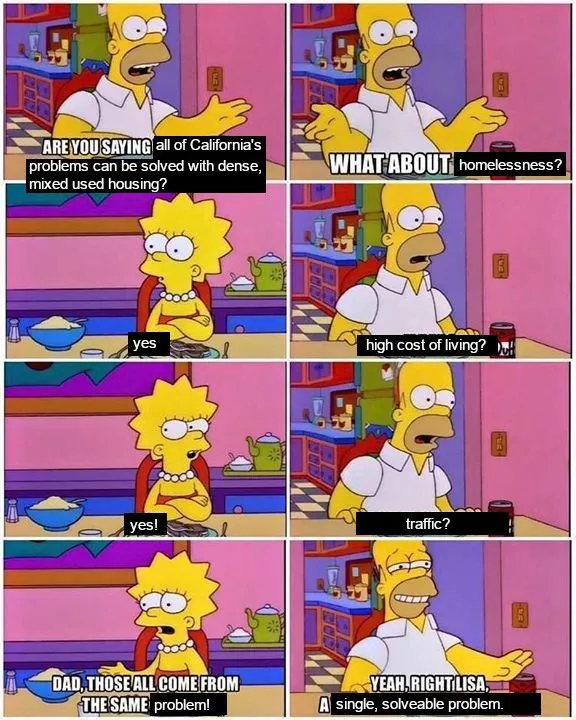this post was submitted on 04 Oct 2023
858 points (93.6% liked)
solarpunk memes
3229 readers
8 users here now
For when you need a laugh!
The definition of a "meme" here is intentionally pretty loose. Images, screenshots, and the like are welcome!
But, keep it lighthearted and/or within our server's ideals.
Posts and comments that are hateful, trolling, inciting, and/or overly negative will be removed at the moderators' discretion.
Please follow all slrpnk.net rules and community guidelines
Have fun!
founded 2 years ago
MODERATORS
you are viewing a single comment's thread
view the rest of the comments
view the rest of the comments

That could alleviate those problems, but I doubt it'd actually solve them. Not to mention, they could also get worse:
Cost of living is tied to supply and demand, more than anything else. When supply is constrained, prices tend to rise.
People often want to have short commutes and to live in walkable areas.
However, most cities in the US and Canada have huge swaths of their metro area zoned exclusively for low density single family housing. Upzoning neighborhoods on the edges of cities is politically difficult.
Cities like NY become expensive because people want to move there, but it's really difficult to add a lot of net-new walkable, transit accessible housing due to zoning, permitting, etc.
If we build a lot of net-new housing, prices will fall.
As for traffic, one of the benefits of mixed use development is being able to walk 5 min to buy groceries, eat at a restaurant or go to a pub. Being able to do many daily chores on foot or bike decreases the number of times you need to either drive or take transit.
Also @[email protected]
This is a "your mileage may vary" case that definitely depends on where you live. Demand can always be artificially inflated
I live within 10km of a very densely populated city (Brazil), zero houses and hundreds of 12+ stories residential apartments. Problem is, the vast majority of apartments are high value. They're also in a very desirable area, so the price of a 24 m² apartment is usually the same of a 140 m² house in a less desirable place within 15km
What about moving within said city? There's plenty of stuff within walking distance, which is great, but the majority of people that do live there work in a different city. Also, most people that work there come from other cities. Since the only "real" public transport is a nearly straight line of metro, traffic is an absolute mess most of the day. I strongly suspect that the original planning wasn't for such high density, especially when you account for the ridiculously low number of bus lines from there to anywhere and back, but I'd need to do proper research to assert for sure.
Ooh my first mention!
I'm not familiar with Brazil's housing situation specifically but building more affordable homes and increasing social housing stock would increase the supply and reduce prices.
Definitely feel you on the lack of jobs locally. Its going to take provincial or national planning and investment to fix.
Sounds like a major enough city, I think most major European cities with subways usually have multiple crossing lines and a decent bus network to fill the gaps. Interestingly I don't even think that's the weirdest metro layout, personally I have to give it to Glasgow. They have a single subway loop that runs 2 directions and its the 3rd oldest underground rail transit system but it hasn't had the route changed or expanded in 125 years. They do have an advantage of having a decent bus system though.
For the cost of living thing, ideally you just implement similar good urban planning across the country. The reason some places are so expensive is because they have relatively livable cities compared to most of the country, so people want to move their. If you just improve the cities in places people already want to be for some reason or another, then you'll just get more people across the country interested in being there unless they have similar options near them. Guess you could alternatively make enough housing for like 50 million people in that one city. Technically, there's always the excuse of "you just didn't build enough". Not sure how the cost per housing unit gets for super structures, particularly since the cost of them includes infrastructure costs we don't usually value into the cost of the home (pipes, roads, etc) and commercial spaces + residential which would make a small city with huge population possible.
The problem is corporations, and lack of regulation and social services.